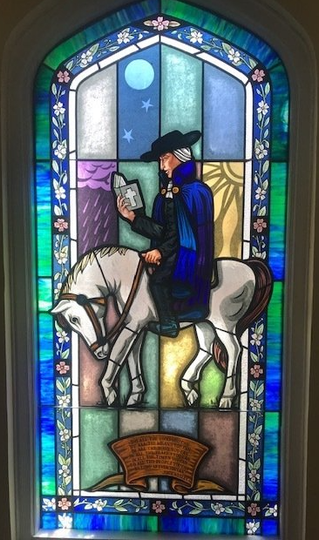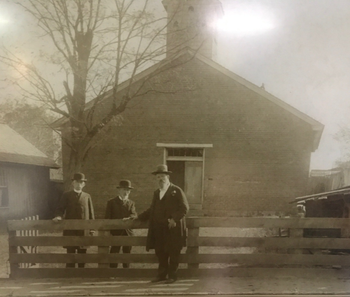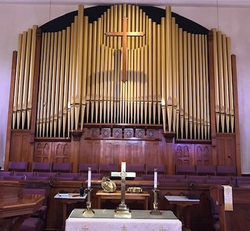HISTORY

"Do all the good you can
by all the means you can
in all the ways you can
in all the places you can
in all the times you can
to all the people you can
as long as ever you can"
John Wesley
Stained Glass window located by the lobby stairs heading up to the 2nd floor.
Early Methodism
The Church was formally organized in 1784. The Church operated directly under the authority of John Wesley and only as members of Methodist "Societies." These study, worship and service societies were not considered to be churches. The members were encouraged to attend their local Anglican Church. However, it was not always possible to fellowship in an Anglican Church, especially in America. The need for baptism and the Lord's Supper among his followers finally convinced Wesley to ordain leaders for administering the Sacraments among Methodists. During the next ten days after December 24, 1784, the Methodist Episcopal Church was organized for the first time anywhere.
A church building was not built in McMinnville before 1837. Religious services were held in the court house and in the school buildings. However, an organized Methodist congregation must have been in existence before 1836, for there is a record that the Second Quarterly Conference met at the McMinnville church in that year. Various dates are listed as to when the first church building for the Methodist congregation in McMinnville was erected.
Goodspeed's History (1887) contains this sentence: "The Methodist Episcopal Church South was erected in 1838, costing about about $1,200. Yet another source gives the following information: "In 1847 the construction of a frame building was begun at the rear of the William H. And Edgar Magness Memorial Library and Community House, facing north Chancery Street and opposite the present building. The building was not completed by 1851; therefore, a committee was appointed with instructions to sell the unfinished structure and take subscriptions for a brick building. The building was completed on the same site in 1852."
Va

The Methodist Church of McMinnville was organized in 1843 and built this brick building in 1852 on the Northeast corner of Chancery and West Main Street. This church faced west. The men pictured are, left to right, Rev. J.A. Orman, Rev. WM Green and Rev. W.D. Cherry
Building the Church
By a deed dated April 12, 1884, John H. French conveyed a lot, number 40, on which the First United Methodist Church is located. The purchase price of the lot was $1,100 cash. One person who left a visible reminder on the new edifice was Clay Faulkner, an industrialist, owner of the Mountain City Woolen Mills and part owner, along with his father, of several other mills in the county. A glance at the structure will reveal the marks of all Faulkner buildings: Great limestone foundations, handsome handmade bricks that have not changed or even chipped in the last hundred years, and arches that enhance all windows and doors. At the time of the construction of the church, Mr. Faulkner was erecting Great Falls Mills at Rock Island. While workmen made bricks for the mill, they made enough for the First United Methodist Church.
By the summer of 1886, the work had progressed to the extent that the congregation had the ceremony of placing the cornerstone in the building. The great stone weighed over 5,000 pounds. The day for the laying of the cornerstone came, Souther Standard of August 28, 1886 carried this account: "There were perhaps a thousand visitors here Wednesday from the county and elsewhere to witness the ceremony of the laying of the cornerstone of the new Methodist Church and to partake of the barbecue which was spread in the park."
A new addition was added on to the existing building in 1940.

The church as it appeared in 1889, soon after it was competed. The home of Dr. Thomas Smartt, built in the 1820's is seen where the Willis Memorial addition now stands.
Description of the Sanctuary
Upon entering the sanctuary from either of the tower foyers, the first impression is of the cheerful brightness resulting from the many tall windows with art glasspanes of pastel colors, divided by wooden mullion. Sometime ago the interior of the original building underwent some alterations, but not to the detriment of the structural design, which has been left unchanged.
Dominating the sanctuary is the massive organ with the pipes. The pipe organ, the largest in the county, has 37 ranks of pipes, two keyboards and 46 stops including chimes. The pipe organ was purchased and installed in 1913. The old oak pews are of simple design, and every aisle post has a small amount of carving highlighted with the St. Andrew's cross deeply cut into the side at the top of the pew. The First United Methodist Church is of great historic and architectural value to the McMinnville-Warren County community and gives character and stability to the downtown district of McMinnville.
Additional Information
Just as slavery was the primary cause of the War Between the States, so was it the cause of the tragic division in the church. The church in the United States was first known officially as the Methodist Episcopal Church. However, many years before the outbreak of war, the slavery issue had aroused bitter attitudes between the residents of the North and South. Consequently in 1844 at the General conference came the break between the Northern and Southern conferences. The Southern Methodist became the Methodist Episcopal Church South and continued to have that title until in 1939 a plan was developed for the union of the Methodist Episcopal churches, North and South, and the Methodist Protestant Church. At that time the church simply became the Methodist Church and remained so until 1969, when the Evangelical United Brethern merged with the Methodist.
Therefore, the word "United" became a part of the church's name, which is now the United Methodist Church. Preceding the principal title, often other words, such as First, Christ, McKendree, West End, among others, are used. "First" is often used as a part of the designation simply because that church was the first in a particular town or locality.

Pipe Organ in the sanctuary
This history information was taken from the book "History of First United Methodist Church McMinnville, Tennessee"
It was compiled and edited by Lila Rose Denton and Alene Boyd.
Published in 1984
The Bicentennial Year of American Methodism.